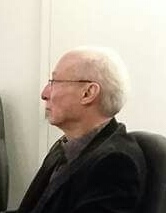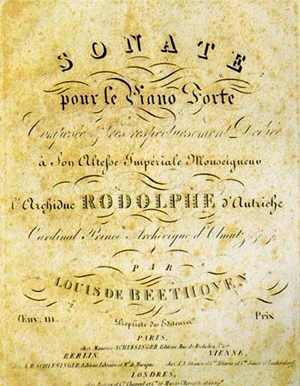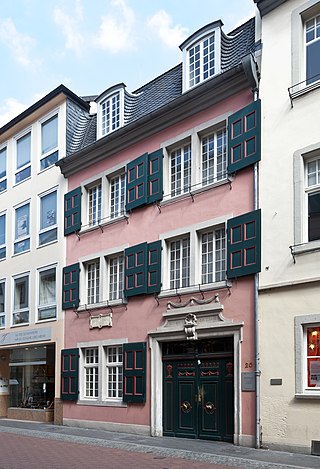Related Research Articles

Ludwig van Beethoven was a German composer and pianist. Beethoven remains one of the most admired composers in the history of Western music; his works rank amongst the most performed of the classical music repertoire and span the transition from the Classical period to the Romantic era in classical music. His career has conventionally been divided into early, middle, and late periods. His early period, during which he forged his craft, is typically considered to have lasted until 1802. From 1802 to around 1812, his middle period showed an individual development from the styles of Joseph Haydn and Wolfgang Amadeus Mozart, and is sometimes characterized as heroic. During this time, he began to grow increasingly deaf. In his late period, from 1812 to 1827, he extended his innovations in musical form and expression.

Mauricio Raúl Kagel was an Argentine-German composer.

The Piano Sonata No. 14 in C-sharp minor, marked Quasi una fantasia, Op. 27, No. 2, is a piano sonata by Ludwig van Beethoven. It was completed in 1801 and dedicated in 1802 to his pupil Countess Giulietta Guicciardi. The popular name Moonlight Sonata goes back to a critic's remark after Beethoven's death.

The toy piano, also known as the kinderklavier, is a small piano-like musical instrument. Most modern toy pianos use round metal rods, as opposed to strings in a regular piano, to produce sound. The U.S. Library of Congress recognizes the toy piano as a unique instrument with the subject designation, Toy Piano Scores: M175 T69. The most famous example of a dedicated composition for the instrument is the "Suite for Toy Piano" (1948) by John Cage.

The Violin Concerto in D major, Op. 61, was written by Ludwig van Beethoven in 1806. Its first performance by Franz Clement was unsuccessful and for some decades the work languished in obscurity, until revived in 1844 by the then 12-year-old violinist Joseph Joachim with the orchestra of the London Philharmonic Society conducted by Felix Mendelssohn. Joachim would later claim it to be the "greatest" German violin concerto. Since then it has become one of the best-known and regularly performed violin concertos.

Maurizio Pollini is an Italian pianist. He is known for performances of compositions by Beethoven, Chopin and Debussy, among others. He has also championed and performed works by contemporary composers such as Pierre Boulez, Karlheinz Stockhausen, George Benjamin, Roberto Carnevale, Gianluca Cascioli and Bruno Maderna. Works composed for him include Luigi Nono's ..... sofferte onde serene ..., Giacomo Manzoni's Masse: omaggio a Edgard Varèse and Salvatore Sciarrino's Fifth Sonata.
Werke ohne Opuszahl (WoO), also Kinsky–Halm Catalogue, is a German musical catalogue prepared in 1955 by Georg Kinsky and Hans Halm, listing all of the compositions of Ludwig van Beethoven that were not originally published with an opus number, or survived only as fragments. The work was originally titled in German Das Werk Beethovens: Thematisch-bibliographisches Verzeichnis seiner sämtlichen vollendeten Kompositionen.

The Piano Concerto No. 5 in E-flat major, Op. 73, known as the Emperor Concerto in English-speaking countries, is a concerto composed by Ludwig van Beethoven for piano and orchestra. Beethoven composed the concerto in 1809 under salary in Vienna, and he dedicated it to Archduke Rudolf, who was his patron, friend, and pupil. Its public premiere was on 28 November 1811 in Leipzig, with Friedrich Schneider as the soloist and Johann Philipp Christian Schulz conducting the Gewandhaus Orchestra. Beethoven, usually the soloist, could not perform due to declining hearing.

The Violin Sonata No. 9, Op. 47 in A major, by Ludwig van Beethoven, is an 1803 sonata for piano and violin notable for its technical difficulty, unusual length, and emotional scope. It is commonly known as the Kreutzer Sonata after the violinist Rodolphe Kreutzer, to whom it was ultimately dedicated, but who thoroughly disliked the piece and refused to play it.

The Stroh violin or Stroviol is a type of stringed musical instrument that is mechanically amplified by a metal resonator and horn attached to its body. The name Stroviol refers to a violin, but other instruments have been modified with the amplification device, including the viola, cello, double bass, ukulele, mandolin, and guitar. John Matthias Augustus Stroh, an electrical engineer in London, invented the instrument in 1899.

Ensemble Modern is an international ensemble dedicated to performing and promoting the music of modern composers. Formed in 1980, the group is based in Frankfurt, Germany, and made up variously of about twenty members from numerous countries.

Jörg Wolfgang Demus was an Austrian classical pianist who appeared internationally and made many recordings. He was also a composer and a lecturer at music academies. In composition and playing, he focused on chamber music and lieder. He played with singers such as Elisabeth Schwarzkopf and Dietrich Fischer-Dieskau, as a piano duo with Paul Badura-Skoda, and with string players such as Josef Suk and Antonio Janigro. Demus was instrumental in bringing the historic fortepiano to concert podiums. He was a member of the Legion of Honour, among many awards. He is regarded as one of the leading Austrian pianists of the immediate post-World War II era.
Ian Geoffrey Pace is a British pianist. Pace studied at Chetham's School of Music, The Queen's College, Oxford and the Juilliard School in New York. His main teacher was the Hungarian pianist György Sándor.

Yves Daoust is a Canadian composer who is particularly known for his works of electroacoustic music. He currently resides in Montréal.
Michel van der Aa is a Dutch composer of contemporary classical music.

The Catalogues of Beethoven compositions are all of the different ways in which the musical compositions by Ludwig van Beethoven have been organized by researchers into his music.

The Beethoven House in Bonn, Germany, is a memorial site, museum and cultural institution serving various purposes. Founded in 1889 by the Beethoven-Haus association, it studies the life and work of composer Ludwig van Beethoven.
The composer Ludwig van Beethoven has been the subject of a number of biographical films.

Sankt-Bach-Passion is an oratorio composed by Mauricio Kagel in 1985 for the tricentenary of the birth of Johann Sebastian Bach. It follows the model of Bach's Passions, but the topic is not biblical, rather refers to Bach's biography. The text includes documents such as Bach's letters to patrons, and excerpts from contemporary biographies. The work is an extended oratorio for soloists, choir, and orchestra. It was premiered in Berlin in 1985, conducted by the composer, and recorded shortly afterwards by the same performers.
The Violin Sonata in A major, Hess 46, is a fragmentary and possibly unfinished work for piano and violin composed by Ludwig van Beethoven sometime between 1790 and 1792. Discovered by musicologist Willy Hess, it may be one of Beethoven's first attempts at composing a work for this combination of instruments.
References
- 1 2 Szendy, Peter (2008). Listen: A History of Our Ears. Fordham University Press. pp. 137–140. ISBN 978-0-823-22800-3.
- 1 2 3 "Ludwig van A Report by Mauricio Kagel (Germany 1970)". Berlin Philharmonic . Retrieved 24 July 2012.
- ↑ Jack, Adrian (19 September 2008). "Mauricio Kagel". The Guardian . Retrieved 24 July 2012.
- 1 2 3 4 5 Nikolaos, Stavlas (2012). Reconstructing Beethoven: Mauricio Kagel's Ludwig van (PDF) (PhD thesis). Goldsmiths, University of London. pp. 46–88.
- ↑ Clark, Philip (5 September 2011). "Ludwig van – Beethoven's legacy 200 years on…". Gramophone . Retrieved 24 July 2012.